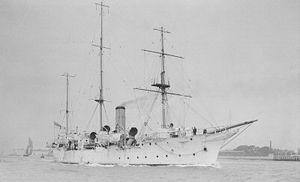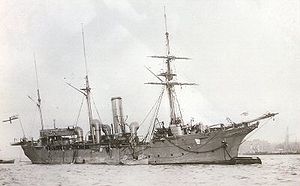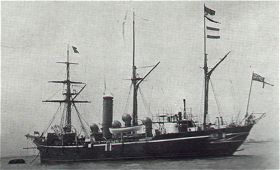Cadmus class sloop
  HMS Espiegle c.1910 under power (top) HMS Merlin at a buoy in grey wartime paint (bottom) | |
| Class overview | |
|---|---|
| Name: | Cadmus-class sloops |
| Builders: | Sheerness Dockyard |
| Operators: | |
| Cost: | £80,796 (Clio) £76,657 (Cadmus)[1] |
| Built: | 1900–1903 |
| In commission: | 1900–1925 |
| Completed: | 6 |
| General characteristics | |
| Type: | Screw Steel Sloop |
| Displacement: | 1,070 tons[2] |
| Length: | 210 ft (64 m) |
| Beam: | 33 ft (10 m) |
| Draught: | 11.5 ft (3.5 m) |
| Installed power: | 1,400 horsepower (1,044 kW)[3] |
| Propulsion: |
Niclausse or Babcock boilers[3] Three-cylinder vertical triple expansion steam engine; Twin screws[2] |
| Sail plan: |
Barquentine-rigged, later removed (Espiegle was never fitted with sails) |
| Endurance: | 4,000 nmi (7,400 km) at 10 kn (19 km/h)[2] |
| Complement: | 130[4] |
| Armament: |
|
| Armour: | Protective deck of 1 in (2.5 cm) to 1.5 in (3.8 cm) steel over machinery and boilers.[2] |
The Cadmus class was a six-ship class of 10-gun[2] screw steel sloops [4] built for the Royal Navy between 1900 and 1903.
Contents
Design
The Cadmus class was constructed of copper-sheathed steel to a design by William White, the Royal Navy Director of Naval Construction.[2] Propulsion was provided by a three-cylinder vertical triple expansion steam engine developing 1,400 horsepower (1,000 kW) and driving twin screws.[2] They were an evolution of the Condor-class sloop, carrying more coal, which in turn gave a greater length and displacement. This class comprised the very last screw sloops built for the Royal Navy, and Espiegle was the last Royal Navy ship built with a figurehead.
Sail plan
As designed and built the class was fitted with a barquentine-rigged sailplan. After HMS Condor was lost in a gale in 1901, the Admiralty abandoned sails entirely.[5] Espiegle was never fitted with sails[2], and all other ships of the class had their sails removed before 1914.
Armament
The class was armed with six 4in/25pdr (1ton) Quick Firing Breech loaders and four 3-pounder Quick Firing Breach Loaders, as well as several machine guns.[2] Fantome had her armament reduced to two QF 3-pounders for survey work.[6]
Ships
| Name | Ship Builder | Launched | Fate |
|---|---|---|---|
| HMS Espiegle | Sheerness Dockyard | 8 December 1900 | Sold at Bombay on 17 September 1923[2] |
| HMS Fantome | Sheerness Dockyard | 23 March 1901 | Survey ship 1906, sold at Sydney 30 January 1925[2] |
| HMS Merlin | Sheerness Dockyard | 30 November 1901 | Survey Survey ship 1906, sold at Hong Kong on 3 August 1923[2] |
| HMS Odin | Sheerness Dockyard | 30 November 1901 | Sold at Bombay on 12 November 1920[2] |
| HMS Clio | Sheerness Dockyard | 14 March 1903 | Sold at Bombay on 12 November 1920[2] |
| HMS Cadmus | Sheerness Dockyard | 29 April 1903 | Sold at Hong Kong on 1 September 1921[2] |
Operational histories
The design of the Cadmus class differed from the screw sloops of the 1860s only in an evolutionary sense (although constructed of steel and armed with quick-loading guns, they retained the sails and layout of the earlier vessels); by the turn of the twentieth century they were thoroughly obsolete. The overseas Stations of the Royal Navy were responsible for patrolling the maritime British Empire, and these ships were intended for that role. The rapidity with which they were sold or converted to survey ships gives testament to their out-moded design. According to Hansard, it was stated by the Secretary to the Admiralty in Parliament on 6 March 1905 that
| “ | they were never designed for fighting purposes but for subsidiary work in peace or war, for which they are still available, and in which they are at the present moment engaged | ” |
HMS Espiegle
On commissioning, Espiegle joined the China Station. Due to the threat to British subjects and interests in Yingkou (then known as Newchwang) from the Russo-Japanese war, she was sent to the Liao River during 1903-1904, where she wintered in the river in a mud dock dug out for her.[7] Once the ice had melted she made passage to Wei-hai-wei, passing Port Arthur at daylight on 13 April 1904, witnessing exchanges of fire between Japanese and Russian ships.
By 1914 Espiegle was on the East Indies Station.[3] She took part in the operations in the Shatt-al-Arab in November 1914 with Odin, reaching as far as Basra. She was sold at Bombay on 17 September 1923.
HMS Fantome
Fantome served on the North America and West Indies Station, including a period in late 1902 and early 1903 when, under Commodore Montgomerie in HMS Charybdis, she enforced a blockade of the Venezuelan coast.[6] From 1906 Fantome was operated by the Royal Navy Survey Service and conducted survey operations in Australian waters until the outbreak of war in 1914. She was transferred to the Royal Australian Navy on 27 November 1914 as a patrol vessel armed with two 4-inch (100 mm) and four 12-pounder guns. From September 1915 to September 1917 she operated in the Bay of Bengal and South China Sea, and from late 1917 was based at Suva, Fiji performing police duties. She conducted a punitive raid on Malekula in the New Hebrides in October 1918.[8] She was returned to the Royal Navy in April 1920 for service as a survey ship, remaining in Australian waters until she paid off in April 1924. She was sold for scrap at Sydney on 30 January 1925, hulked and used as a barge, mainly in Tasmania. She was finally sold for demolition in 1956.
HMS Merlin
In 1904, Merlin took part in the 4th Expedition of the Somaliland Campaign against the Mad Mullah. The Naval Force included HM Ships Hyacinth, Perseus, Fox, Mohawk and Porpoise. From 1906 she was employed as a survey ship, conducting hydrographic work both at home and abroad. She re-commissioned at Hong Kong on 5 November 1913, and continued to work as a survey vessel, for which her armament was reduced.[9] She was sold at Hong Kong on 3 August 1923.
HMS Odin
Odin spent the first part of her life at the South Atlantic Station. On 23 January 1904 she called at the isolated island of Tristan da Cunha, carrying Mr William Hammond Tooke with an offer to the islanders;
| “ | Should all the inhabitants wish to leave the Island, the Cape and Home Governments would provide them with a free passage, purchase their live stock from them and settle them within 100 miles (160 km) of Cape Town, allowing them about 2 acres (8,100 m2) of land on rent, and would advance them money on loan to start their homes... They would be near the sea coast, where they would be able to start fisheries to supply the people of Cape Town... and that in future they could not rely on a yearly visit from a man-of-war | ” |
After vaccinating children, conducting a census (74 people) and baptising a child, they received the answer of the inhabitants: three families were for, seven against and one neutral. The offer was therefore withdrawn, and the ship carried only one passenger to the Cape, a Mrs Amy Matilda Hagan. Odin steamed for Nightingale Island and Inaccessible Island, before returning to the Cape.[10] By 1909 Odin had become a drill ship for the Cape Naval Volunteers
Cite error: Invalid<ref> tag;
invalid names, e.g. too many, but by March 1914 had recommissioned at Muscat for service on the East Indies Station[11]
October 1914 saw Odin, Espiegle and Dalhousie protecting the Abadan Island oil refineries at the northern end of the Persian Gulf. On 7 October the Turkish Government delivered a formal letter to Espiegle protesting at the violition of Turkish waters within the Shatt-al-Arab. An uneasy peace was sustained until 31 October, when Espiegle learnt that the Turkish Navy had shelled Odessa, thus effectively declaring war. On 5 November Great Britain officially declared war on the Ottoman Empire, and on 6 November Espiegle engaged a series of trenches opposite Abadan Island. On 21 November Espiegle and Odin bypassed a sunken barrage in the Shatt-al-Arab and steamed as far as Basra. A naval landing party put an end to looting in the city.[12] Beyond Basra the waters of the Shatt-al-Arab are too shallow for all but the smallest vessels, and the naval contribution to the Mesopotamian campaign was taken over by an improvised fleet of tugs and paddle steamers[4]
Odin continued to serve on the East Indies Station, and near Aden on 5 March 1917 stopped the German raider Iltis, which was scuttled rather than be captured.[13] She was sold at Bombay on 12 November 1920 on the same day as Clio.
HMS Clio
Clio served her career on the China Station, re-commissioning at Hong Kong in August 1914 and remaining there during World War I.[14] She was sold at Bombay on 12 November 1920 on the same day as Odin.
HMS Cadmus
During the whole of her career Cadmus served on the China Station. She recommissioned at Hong Kong on 18 October 1912 and remained on the China Station during World War I. In 1920 she was listed as "unallocated" at Hong Kong,[15] and was sold there on 1 September 1921.
See also
 Media related to Cadmus class sloop at Wikimedia Commons
Media related to Cadmus class sloop at Wikimedia Commons
References
- ↑ 1.0 1.1 "Hansard, 6 March 1905 vol 142 cc402-3, Questions in the House". http://hansard.millbanksystems.com/commons/1905/mar/06/hms-clio-and-cadmus. Retrieved 2008-09-07.
- ↑ 2.00 2.01 2.02 2.03 2.04 2.05 2.06 2.07 2.08 2.09 2.10 2.11 2.12 2.13 2.14 Winfield, Rif; Lyon, David (2003). The Sail and Steam Navy List, 1815-1889. Chatham Publishing. ISBN 978-1861760326.
- ↑ 3.0 3.1 3.2 "HMS Espiegle at Naval Database website". http://www.pbenyon.plus.com/18-1900/E/01651.html. Retrieved 2008-09-07.
- ↑ 4.0 4.1 4.2 "Cadmus class at battleships-cruisers.co.uk". http://www.battleships-cruisers.co.uk/cadmus.htm. Retrieved 2008-09-07.
- ↑ Fifty Years in the Royal Navy, Admiral Sir Percy Scott, Bt., John Murray, London, 1919, p.37
- ↑ 6.0 6.1 "HMS Fantome at Naval Database website". http://www.pbenyon.plus.com/18-1900/F/01740.html. Retrieved 2008-09-07.
- ↑ The Diaries of Sir Ernest Satow, British Envoy in Peking, Vol 2 (1904-1906), Edited and Annotated by Ian C Ruxton
- ↑ "HMAS Fantome". Sea Power Centre Australia. http://www.navy.gov.au/HMAS_Fantome. Retrieved 2008-09-15.
- ↑ "HMS Merlin at Naval Database website". http://www.pbenyon.plus.com/18-1900/M/03008.html. Retrieved 2008-09-07.
- ↑ "The Annals of Tristan da Cuhna website". http://www.btinternet.com/~sa_sa/tristan_da_cunha/annals_20.html. Retrieved 2008-09-07.
- ↑ "HMS Odin at Naval Database website". http://www.pbenyon.plus.com/18-1900/N/03301.html. Retrieved 2008-09-07.
- ↑ "The Road to Basra 1914, by Christopher Trevelyan at King-Emperor Home website". http://www.king-emperor.com/article2.htm. Retrieved 2008-09-07.
- ↑ "AWM Collection Record P05338.044, Australian War memorial website". http://cas.awm.gov.au/photograph/P05338.044. Retrieved 2008-09-07.
- ↑ "HMS Clio at Naval Database website". http://www.pbenyon.plus.com/18-1900/C/01006.html. Retrieved 2008-09-07.
- ↑ "HMS Cadmus at Naval Database website". http://www.pbenyon.plus.com/18-1900/C/00762.html. Retrieved 2008-09-07.
| ||||||||

